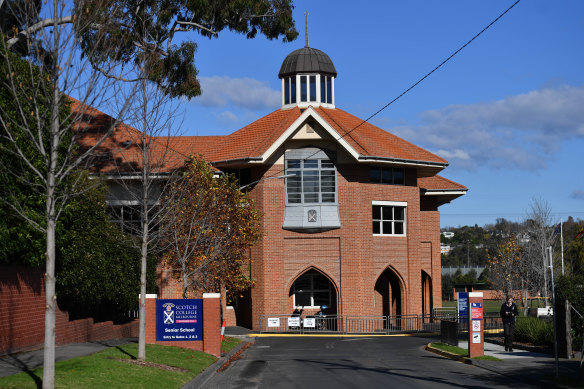- Exclusive
- Politics
- Victoria
- Victorian budget
The elite schools hardest hit by Victoria’s payroll tax change
By Rachel Eddie
Victoria’s high-fee private schools will pay the state government more in taxes than they get in state funding, as analysis from the opposition reveals the financial hit to elite schools from losing payroll tax exemption.
Some schools that charge more than $15,000 a year have already attributed raised fees or new levies to offsetting the cost of the tax change, which was announced last year to slash $35 million a year from government debt.

Scotch College will pay the state government more in taxes than they get in state funding, according to opposition analysis.Credit: Joe Armao
Using publicly available data on employee costs and state government funding, the opposition roughly calculated that the Victorian budget would make a net gain from 57 of the highest-fee private schools in 2025. The state will receive $19.3 million more from those schools than it allocates.
The hardest-hit school will be Haileybury, which will have an estimated $3.4 million difference in 2025 between what it pays in the new tax and what it gets in state funding. Other schools facing a funding gap include Wesley College ($2.1 million), Scotch College ($1.4 million) and Caulfield Grammar, Xavier College and Carey Baptist Grammar (all $1.3 million).
The opposition did not count funding from the Commonwealth, which is responsible for providing 80 per cent of government cash to private schools. Independent Schools Victoria backed the analysis and said it matched its own modelling.
Collectively, the schools would pay the state an estimated $101.8 million in tax and receive $82.4 million in state funding next year. Just 15 of the 57 schools would still end up benefiting overall from the state.
The opposition has long argued all schools should be exempt from the tax.
“Dozens of schools are now having to pay the Allan government millions of dollars just to continue their much-needed work providing education to Victorian children,” opposition education spokeswoman Jess Wilson said.
“Non-government schools are an essential part of our education system – they take significant pressure off the government system – and shouldn’t be made to pay for the privilege of providing educational choice to parents and students across the state.”
Independent Schools Victoria acting chief executive Meg Hansen said the data aligned with its own modelling, which found about three-quarters of affected schools would pay the government more than they received in state funding.
“They are effectively being hit with a financial penalty for educating children,” Hansen said.
States are responsible for 20 per cent of government funding for private schools, but the opposition analysis found most of the highest-fee schools did not get to keep it.
However, Geelong Grammar – Australia’s highest-fee school, climbing 36 per cent in the decade – charges more than $50,000 for year 12, but would still end up an estimated $348,000 ahead on state funding on the assumption it is charged the lower regional rate of payroll tax.
Australian Curriculum, Assessment and Reporting Authority data released last year found that 98 per cent of public schools were still funded below the standards recommended by the landmark Gonski review, while 98 per cent of private schools were funded above it.
The Commonwealth this year benchmarked the school resource standard at $13,557 for every primary school student and $17,036 per secondary student. The state argues that any school bringing in more than $15,000 in annual fees, while also receiving minimum government funding of $2612 per student, had resources to spare.
On Tuesday, a Victorian government spokeswoman said more than 90 per cent of private schools remained exempt from payroll tax.
“We listened closely to schools on this policy – and increased the threshold to make sure only Victoria’s high-fee schools are subject to payroll tax,” she said.
“Every government school in Victoria pays payroll tax. It’s only fair that the highest-fee private schools now also contribute.”
Payroll tax from public schools goes into the same pool of government cash that funds them.
Victoria initially planned to target about 110 schools but reduced this to about 60 after a campaign against the policy.
The opposition used the employee costs that each school publicly reported in 2022 to the Australian Charities and Not-for-profits Commission, and indexed the total amount 2.01 per cent a year to make its calculations.
St Kevin’s College was not included in the analysis because the school reports under the Edmund Rice Group, not individually.
The modelling assumed Geelong College and the Hamilton and Alexandra College would also be charged the lower regional rate of payroll tax and that all others would be charged the higher metropolitan rate.
The Age last month revealed that Mordialloc MP Tim Richardson lobbied senior ministers to exempt a high-fee private school in his electorate in leaked letters.
Education Minister Ben Carroll, the deputy premier, at the time said it was about equity. He said he was confident no student would be worse off.
“I think it is fair that a school with a golf course, 100 acres, plans for a hockey pitch, soccer fields [pays the tax]. This is about equity,” Carroll said last month.
Start the day with a summary of the day’s most important and interesting stories, analysis and insights. Sign up for our Morning Edition newsletter.